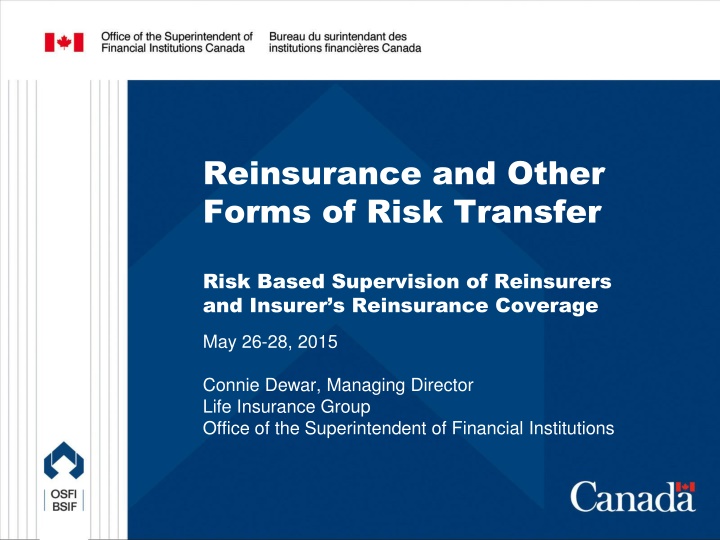
OSFI's Risk-Based Supervision Framework
Gain insights into the risk-based supervision approach of the Office of the Superintendent of Financial Institutions (OSFI) in Canada, including oversight functions, supervisory framework, and core processes for ensuring financial stability and protection of stakeholders.
Download Presentation

Please find below an Image/Link to download the presentation.
The content on the website is provided AS IS for your information and personal use only. It may not be sold, licensed, or shared on other websites without obtaining consent from the author. If you encounter any issues during the download, it is possible that the publisher has removed the file from their server.
You are allowed to download the files provided on this website for personal or commercial use, subject to the condition that they are used lawfully. All files are the property of their respective owners.
The content on the website is provided AS IS for your information and personal use only. It may not be sold, licensed, or shared on other websites without obtaining consent from the author.
E N D
Presentation Transcript
Reinsurance and Other Forms of Risk Transfer Risk Based Supervision of Reinsurers and Insurer s Reinsurance Coverage May 26-28, 2015 Connie Dewar, Managing Director Life Insurance Group Office of the Superintendent of Financial Institutions
A few facts about OSFI A few facts about OSFI Established in 1987 as an independent agency of the Government of Canada reporting to Parliament through the Minister of Finance Supervises and regulates more than 400 deposit-taking institutions and insurers and more than 1200 federally registered private pension plans 1
As a prudential supervisor OSFI is focused on Protecting depositors, policyholders and creditors of financial institutions and pension plan beneficiaries Contributing to public confidence in a strong, stable and competitive financial system in Canada 2
Oversight activities can be grouped in two functions Regulation Evaluate system-wide risks Promote sound business and financial practices through guidelines, policies and recommendations Supervision Identify institution-specific and systemic risks and trends Intervene in a timely manner to minimize losses to depositors, policyholders, creditors and pension plan members 3
OSFIs Supervisory Framework Describes the principles, concepts and core process that OSFI uses to guide its supervision of institutions General Approach Consolidated supervision Principles-based Intensity and intervention Board & senior management accountability 4
Core Supervisory Process OSFI has a three staged cyclical supervisory process Planning Supervisory work: The supervisory strategy identifies the supervisory work necessary to keep the institution s risk profile current. The intensity of supervisory work depends on the nature, size, complexity and risk profile of the institution Executing Supervisory Work and Updating the Risk Profile: Monitoring Desk reviews On-site reviews Reporting and Intervention: OSFI sends an annual supervisory letter to the institution and it is the primary form of communication. It summarizes OSFI s key findings and recommendations. Occasionally, OSFI will also send interim letters to the institution so as to provide the institution with timely feedback on issues in a specific area. 5
Key Principles of Supervision Focus on material risk Forward-looking, early intervention Sound predictive judgment Understanding drivers of risk Differentiate inherent risks and risk management Dynamic adjustment Assessment of the whole institution 6
Risk Matrix anchors OSFI supervisory Risk Matrix anchors OSFI supervisory framework framework Significant Activities Direction of Risk Inherent Risks Quality of Risk Management Net Risk Importance Compliance Regulatory Management Risk Management Senior Management Board Operational Financial Insurance Market Operational Compliance Credit Actuarial Internal Audit Strategic Activity 1 Activity 2 Reinsurance Activity Overall Rating Rating Direction Time Frame Earnings Capital Liquidity Intervention Rating Composite Risk 7
Comparing Composite Risk Ratings and Comparing Composite Risk Ratings and Intervention Ratings Intervention Ratings Composite Risk Rating Low Moderate Intervention Rating 0 Normal 0 Normal 1 Early Warning 1 Early Warning 2 Risk to financial viability or solvency 2 Risk to financial viability or solvency 3 Future financial viability in serious doubt 4 Non-viable / insolvency imminent Above Average High 8
Guideline B-3 Sound Reinsurance Practices and Procedures Four principles: 1. Reinsurance risk management policy 2. Due diligence of reinsurance counterparties 3. Terms and conditions / contract clarity and certainty 4. Ceding company not adversely affected by terms and conditions 9
1. Reinsurance risk management policy Institution s approach to managing risks through reinsurance including purpose and objectives Reflects the scale, nature and complexity of business Describes approach to reinsurance Specifies roles and responsibilities Assesses adequacy and effectiveness of reinsurance Board oversight & senior management implementation 10
2. Due diligence of reinsurance counterparties Evaluate abilities of reinsurers Commensurate with level of exposure Not solely rely on 3rd parties Evaluation of counterparties should be updated regularly Higher level of due diligence for unregistered reinsurers 11
3. Terms and conditions / contract clarity and certainty Binding contract prior to the effective date of coverage Summary documents may be adequate but should be contractually binding Final executed documents completed in a timely manner Reinsurance contracts should stand on their own 12
4. Ceding company not adversely affected by terms and conditions Include an appropriate insolvency clause Insolvency Clause provides for the continuance of payments of the obligations of the reinsurer as though no insolvency had occurred Appropriate use of off-set , cut-through and funds withheld Off-set permits each party to meet amounts due against those payable before making payment Cut-through in the event of ceding company s insolvency, any loss covered under the reinsurance agreement be paid by the reinsurer directly to the insured Funds Withheld assets that would normally be paid over to a reinsure are withheld by the ceding company to reduce potential credit risk Reinsurer must meet obligations, even when ceding company is insolvent 13
Administration Applies to all federally regulated financial institutions Potential consequences of not adhering Loss of capital or asset credit Increased target level of capital/assets required Annual reinsurance declaration to the Board Credit for Reinsurance Regulated in Canada Receives full credit for reinsurance Ceding company releases reserves as well as MCCSR capital requirements Not Regulated in Canada In order to receive credit, must collateralize both the reserves and capital requirements of ceded business Reinsurer must post collateral equal to 100% of the ceded reserves plus 150% of the ceded MCCSR capital requirement Amounts not collateralized remain with the ceding company 14
Reinsurance Security Agreements (RSA) Valid and enforceable security interest that has priority over any other security interest in assets of an unregistered reinsurer that are held in Canada Capital/Asset eligibility Pledged assets in Canada Collateral agent Legally enforceable Right to liquidate on default of reinsurer Securities not issued by reinsurer 15
Reinsurance Security Agreements (RSA) Legal opinion Monthly reporting to OSFI Board approved Types of acceptable assets and limits Practices and procedures for managing and controlling risks Confirmation every two years 16
For further information www.osfi-bsif.gc.ca OSFI s Supervisory Framework: http://www.osfi-bsif.gc.ca/eng/fi-if/rai-eri/sp-ps/pages/sff.aspx B-3 Sound Reinsurance Practices and Procedures: http://www.osfi-bsif.gc.ca/eng/fi-if/rg-ro/gdn-ort/gl-ld/pages/b3_sound.aspx Guidance for Reinsurance Security Agreements: http://www.osfi-bsif.gc.ca/eng/fi-if/rai-eri/sp-ps/pages/rsa.aspx 17
Questions? 18


